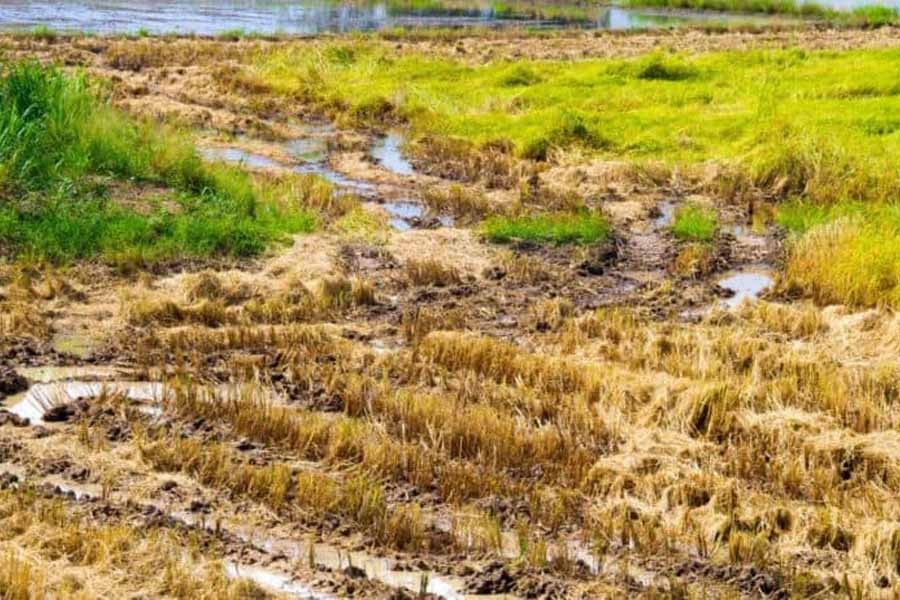
Published :
Updated :

Like any other country, Bangladesh embraces both favourable and unfavourable ecosystems. Unfavourable or fragile ecosystems occupy a substantial proportion of land and population in Bangladesh where poverty is pervasive. The flood-prone ecosystem accounts for roughly one-thirds of the population as well as land area; the saline coast absorbs roughly one-fifths of the population and land. Thus, two-thirds of population and land areas seem to be located in adverse ecology. This possibly points to the fact that if fragility of ecosystem affects household income adversely, giving higher priority to development interventions in these ecologies can help substantial improvement in food security and nutrition at the national level.
Drawing upon a household level panel data, the most dramatic change in income structure occurs in coastal zone where agriculture comprised roughly 60 per cent of household income in the 1980s, but the share almost halved in recent periods. Special mention may be made of income from rice that drastically reduced whereas income from rice was an important source back long time. On the other hand, the share of non-agricultural income rose from about 56 to 70 per cent during the same period of time. The share of remittance income also shot up from about 8.0 per cent to about 30 percent over time. It may be mentioned that such changes also happened in other zones but not as sharply as in coastal zones.
The growth of household level per capita income grew at 3.0 per cent in favourable and coastal zones in early decades but only at 1.0 per cent in flood- prone zones. In recent periods, per capita income rose by over 6.0 per cent in all zones. Over a long-term period, per capita income growth exceeded 4.0 per cent. At disaggregated level, agricultural income grew at negative rates in all areas during 1988-2000 but picked up quite well during 2000-2014. This means that the improvement in growth rates of per capita income can be adduced mostly to the growth of non-agricultural income.
Available data show that both flood-prone and coastal ecosystems have substantial lower, even negative rates of agricultural income. But the households in the coastal ecosystem cover most of the disadvantages through higher non-farm incomes from higher non-land fixed assets, higher educated workers, and higher incidence of overseas migration of workers. So, the difference of household incomes is only marginal. In the flood-prone ecosystem, the non-agricultural income is also lower compared to the favourable ecosystem, because lower average year of schooling of worker and lower value of non-land fixed assets. The households in the flood-prone ecosystem also avail of the opportunities of overseas migration compared to favourable ecosystem, but to a much lower extent than the households in the coastal ecosystem.
An econometric model on the determinants of household level income shows that a household earns on an average US$ 1298 from an acre of land under its ownership. If the land is rented, the return is lower by 20 per cent due to the payment of rent to the landowner. The rate of return on capital is about 28 per cent in agriculture and 24 per cent in non-agriculture. A male worker earns US$577 (US$ 2.22) per day assuming an employment of 5 days per week). A female worker earns 20 per cent less than a male worker. A year of schooling gives a return of US$ 64 for a male worker and US$ 85 for a female worker. If the household has a member working abroad, the remittance sent augments household income by US$2,356 (also 98 per cent of average household income).
The coefficient of the dummy variables representing fragile environment are negative and statistically significant. A household living in the flood-prone ecosystem earns on the margin US$ 394 (16 percent) less than a household living in a favourable environment. For the households in the coastal saline environment the income is lower by US$ 447 (19 percent). Thus the hypothesis that household income is equal across agro-ecology is not validated by the survey data.
In order to determine the most effective strategies for reducing the burden of undernutrition and accelerating development, it is important that the determinants of undernutrition are known. There exists highly significant regional heterogeneity in undernutrition in Bangladesh; alarming high levels are still prevailing in the Haor and coastal belt areas. Hence, an appropriate policy guideline that focuses on altering the nutritional intake among poor children, especially in the regions with higher prevalence of childhood undernutrition is needed; more focused programmes targeting specific issues like 'diversified diet at low cost' should be implemented and evaluated. Intervention strategies may have to be seasonally related for greatest effect. Health workers need to recognise the complex interplay of seasonality in order to find a mix of interventions to address this problem. Here the focus is on the importance of bringing seasonal thinking back into the various current hunger and nutrition debates. Food availability and security issues are major concerns for Bangladesh which have a direct impact on nutritional status. Education (especially of females) should still be one of the key policy options to achieve the SDG on undernutrition in Bangladesh. The multifaceted nature of undernutrition means that it may be effectively addressed only when several sectors and strategic efforts are combined together. Given the well documented synergies between several sectors, combining income generation projects, infant feeding programmes together with better household access to food, and improved sanitation, can bring about improvements in nutritional status in both favourable and unfavourable areas but one size may not fit well. Unfavourable areas need special treatment on few factors such as development of infrastructure, both physical and human. In fact, the lack of access to better infrastructure, nay the markets stand as a binding constraint to improved living in those areas.
Abdul Bayes is a former Professor of Economics at Jahangirnagar./abdulbayes@yahoo.com


 For all latest news, follow The Financial Express Google News channel.
For all latest news, follow The Financial Express Google News channel.